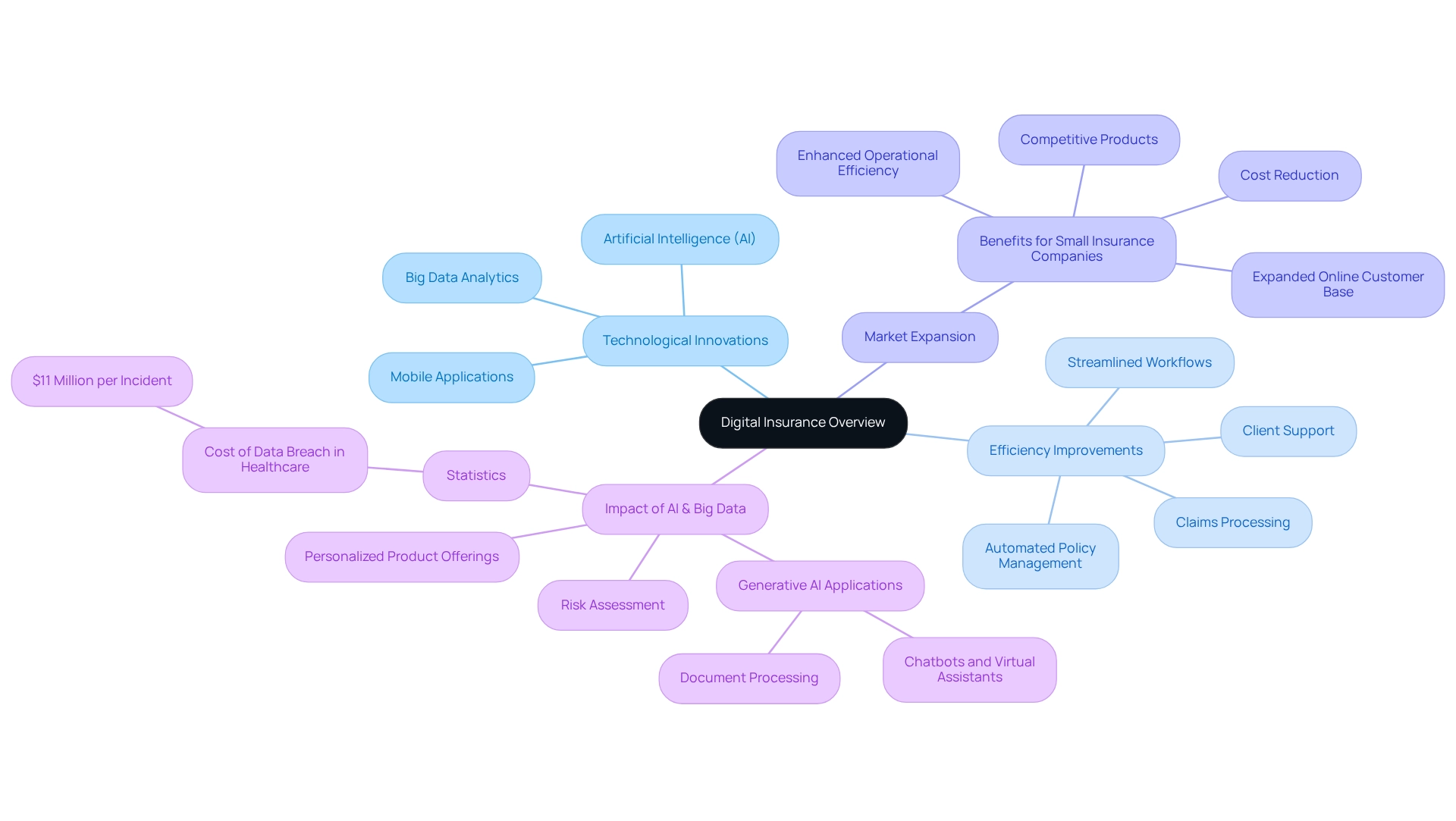Overview
Digital insurance signifies a pivotal transformation within our industry, driven by the integration of advanced technologies such as artificial intelligence, big data analytics, and automation. These innovations not only enhance operational efficiency but also elevate customer engagement.
We understand the challenges faced by modern consumers, and our approach illustrates how these technologies:
- Streamline processes
- Improve risk assessment
- Offer seamless access to services
As a result, we are reshaping the insurance landscape to better meet your needs. Are you ready to embrace this transformation with us?
Introduction
In the rapidly evolving landscape of the insurance industry, we recognize that digital insurance is a transformative force reshaping how we operate and engage with our customers. By harnessing advanced technologies such as:
- artificial intelligence
- big data analytics
- mobile applications
we are streamlining processes and enhancing user experiences like never before. This shift from traditional models to digital solutions not only improves our operational efficiency but also empowers our customers with instant access to information and services. As the digital insurance market continues to expand, particularly among smaller firms, the advantages of adopting these innovations become increasingly evident.
The integration of automation and data-driven decision-making is not just a trend; it is a fundamental change that promises to redefine the future of insurance, ensuring that we remain competitive in a tech-savvy world.
Defining Digital Insurance: An Overview
Electronic coverage represents a significant advancement in the protection industry, characterized by the integration of sophisticated technological innovations that revolutionize the creation, promotion, and management of coverage products. This transformation encompasses an array of tools, including artificial intelligence (AI), big data analytics, and mobile applications, which together streamline operations, enhance user engagement, and refine risk assessment processes.
In contrast to traditional coverage models that often depend on manual workflows and face-to-face interactions, our online services facilitate automated policy management, claims processing, and client support. This shift not only boosts efficiency but also cultivates a more user-friendly experience for our customers. For instance, automation has been crucial in optimizing workflows, mitigating risks, and conserving valuable time and resources.
Recent advancements in online coverage technology in 2025 have propelled the industry forward even further. We anticipate considerable expansion in the online coverage market, driven by the increasing adoption of electronic tools among providers. Small insurance companies, in particular, stand to benefit from digitalization, enhancing operational efficiency and offering competitive products. By leveraging technological solutions, these companies can reduce expenses, expand their online customer base, and utilize data analytics to better understand and meet customer needs. A case study titled ‘Advantages of Modernization for Small Insurance Firms’ illustrates how these companies have successfully embraced technological tools to bolster their operations and competitiveness.
The impact of AI and big data in online coverage is profound. These technologies empower insurers to analyze vast datasets, resulting in more accurate risk assessments and personalized product offerings. Notably, generative AI has emerged as a powerful resource in this landscape, with a remarkable 60% increase in its application for enhancing user experience through advanced chatbots and virtual assistants. Furthermore, over half of financial professionals now employ generative AI for document processing, streamlining operations and boosting productivity across various departments. Additionally, the average cost of a data breach in the healthcare sector was nearly $11 million per incident in 2023, underscoring the urgent need for robust online protection strategies to mitigate such threats. As Claude Shannon envisioned, the future of technology in risk management is promising, with machines playing an increasingly pivotal role in enhancing operational capabilities and customer experiences. Overall, what is digital insurance represents not merely a trend; it signifies a critical transformation that is reshaping the landscape of the coverage sector.

The Evolution of Digital Insurance: Context and Development
The evolution of digital coverage raises the question of what is digital insurance, representing a pivotal transformation in our industry, initiated in the late 1990s when we first embraced online sales channels. This shift has fundamentally altered consumer interactions, allowing individuals to effortlessly compare policies and learn what is digital insurance while purchasing coverage online. As technology has advanced, the introduction of mobile applications and generative AI has further revolutionized our sector, significantly enhancing user experiences and operational efficiencies.
Generative AI has emerged as a formidable asset in financial services, evidenced by a 60% increase in its application for client experience, particularly in the development of sophisticated chatbots and virtual assistants. This trend resonates within the insurance industry, where we are integrating AI technologies to streamline operations and bolster client engagement. For instance, we are leveraging generative AI to automate claims processing and improve service interactions, demonstrating its potential to boost productivity across various departments.
The rise of insurtech firms in the 2010s has introduced innovative business models that challenge traditional insurers, fostering a competitive landscape. These companies have harnessed technology to optimize processes, reduce costs, and enhance client interactions. Notably, telematics-based auto coverage and fully automated claims processing have become standard, illustrating a significant shift toward customer-centric solutions.
Statistics indicate that insurtech firms have experienced remarkable growth over the past decade, with numerous startups successfully capturing market share from established players. This trend underscores the urgent need for traditional insurers to adapt and innovate in response to evolving consumer expectations and technological advancements. Importantly, the average cost of a data breach in the healthcare sector was nearly $11 million per event in 2023, highlighting the critical importance of secure online practices within our field.
As industry leaders emphasize, the integration of technology, including generative AI, is essential for enhancing customer experiences and ensuring the sustainability of our businesses in today’s landscape. We at Vista Projects exemplify how organizations can maximize their investments in technological transformation, stressing the importance of implementing fully utilized systems to avoid resource wastage. Moreover, the ongoing need for comprehensive education to address consumer adoption challenges regarding what is digital insurance remains a significant hurdle, providing a balanced perspective on the evolution of digital services.
Key Characteristics of Digital Insurance: Features and Benefits
Digital coverage is fundamentally defined by its reliance on automation, data-informed decision-making, and enhanced client interaction. Automation serves a pivotal role in streamlining processes such as underwriting and claims management, not only reducing operational costs but also significantly improving efficiency. In fact, recent statistics indicate that automation can lead to a 30% reduction in processing times for claims, enabling us to respond more swiftly to customer needs. However, the implementation costs of new technologies pose a considerable challenge for insurance firms during digitalization, making effective assimilation essential.
Our Hybrid Connection Platform allows insurers to enhance and expand the value of their legacy systems, streamlining intricate connections and significantly lowering expenses. Data analytics further empowers us to evaluate risks with enhanced precision, allowing for the customization of products that closely align with client needs. This capability is crucial in an industry where understanding client profiles can lead to more personalized service offerings. For instance, the integration of AI in document processing for Medicare Set-Asides has demonstrated how technology can create efficiencies in medical reviews, although it also necessitates careful management to mitigate associated risks. Moreover, our digital insurance platforms illustrate what is digital insurance by providing user-friendly interfaces that enable clients to manage their policies, file claims, and access support seamlessly through mobile apps or online portals. These advancements not only enhance customer satisfaction but also foster loyalty by providing a cohesive and intuitive experience. As Gustavo Estrada from BC Provincial Health Services Authority remarked, ‘Avato streamlines intricate projects and produces outcomes within preferred timelines and financial limits,’ underscoring the significance of efficient coordination in attaining these advantages.
As we increasingly focus on improving operational capabilities and reducing costs through the effective integration of legacy systems, the emphasis on automation and data analytics will continue to shape the future of our industry. Leading automation solutions for coverage improve precision and conserve time for brokers, further highlighting the transformative effect of technology on client experiences.
The Importance of Digital Insurance: Enhancing Customer Experience and Efficiency
Digital insurance significantly enhances user experience by providing instant access to information and services, illustrating what is digital insurance. In today’s online environment, clients often ask what is digital insurance, and we enable them to easily compare policies, acquire quotes, and manage their accounts online.
Automation is at the forefront of this transformation, allowing us to handle claims more swiftly and reduce turnaround times, ultimately boosting client satisfaction. For instance, small insurance firms that embrace technology can enhance operational efficiency and competitiveness by integrating electronic tools, which help lower expenses and expand their clientele through online channels.
Organizations implementing electronic claims processing frequently report improved customer retention rates, as clients appreciate the speed and transparency of these services. Furthermore, effective technological transformation sets the standard for forward-thinking insurers, allowing us to meet the needs of tech-savvy consumers while maintaining a competitive edge in a rapidly evolving market.
Our hybrid unification platform plays a crucial role in this landscape by simplifying complex connections and modernizing legacy systems, enabling insurers to streamline operations effectively. The integration of data-driven decision-making frameworks has been shown to increase decision-making speed and enhance accuracy by 15%, underscoring the importance of electronic coverage in optimizing operational efficiency and client engagement.
Additionally, safeguarding sensitive customer information remains a top priority for us, especially in light of concerns about data privacy and cybersecurity, highlighting the need for reliable electronic solutions. Our commitment to ensuring 24/7 availability for essential integrations reinforces the reliability of online insurance solutions, highlighting what is digital insurance and aligning perfectly with our focus on operational efficiency.
As Gustavo Estrada, Acting Provincial Director at BC Provincial Health Services Authority, stated, ‘Avato enabled us to align the outcomes we wanted to achieve in the time frame and price point we were targeting.’
To discover how we can support your digital transformation journey, contact us today.
Conclusion
The evolution of digital insurance stands as a bold testament to the transformative power of technology within our industry. By embracing advancements such as artificial intelligence, big data analytics, and mobile applications, we are not only streamlining our processes but also significantly enhancing customer experiences. The shift from traditional models to digital solutions enables faster claims processing, more accurate risk assessments, and personalized service offerings, ultimately resulting in greater customer satisfaction and loyalty.
As the market continues to grow, particularly among smaller firms, the importance of adopting these digital innovations becomes increasingly clear. Companies that leverage automation and data-driven decision-making can reduce operational costs and better meet the needs of their clients. The competitive landscape is evolving, and those who fail to adapt risk falling behind in a tech-savvy world.
In conclusion, digital insurance is more than just a trend; it represents a fundamental shift in how we operate and engage with our customers. As we navigate this digital transformation, our focus on improving efficiency, enhancing customer experience, and ensuring data security will be paramount. The future of insurance lies in our successful integration of technology, which not only promises to redefine our operational capabilities but also to deliver a more responsive and customer-centric approach that meets the demands of an ever-evolving market.

